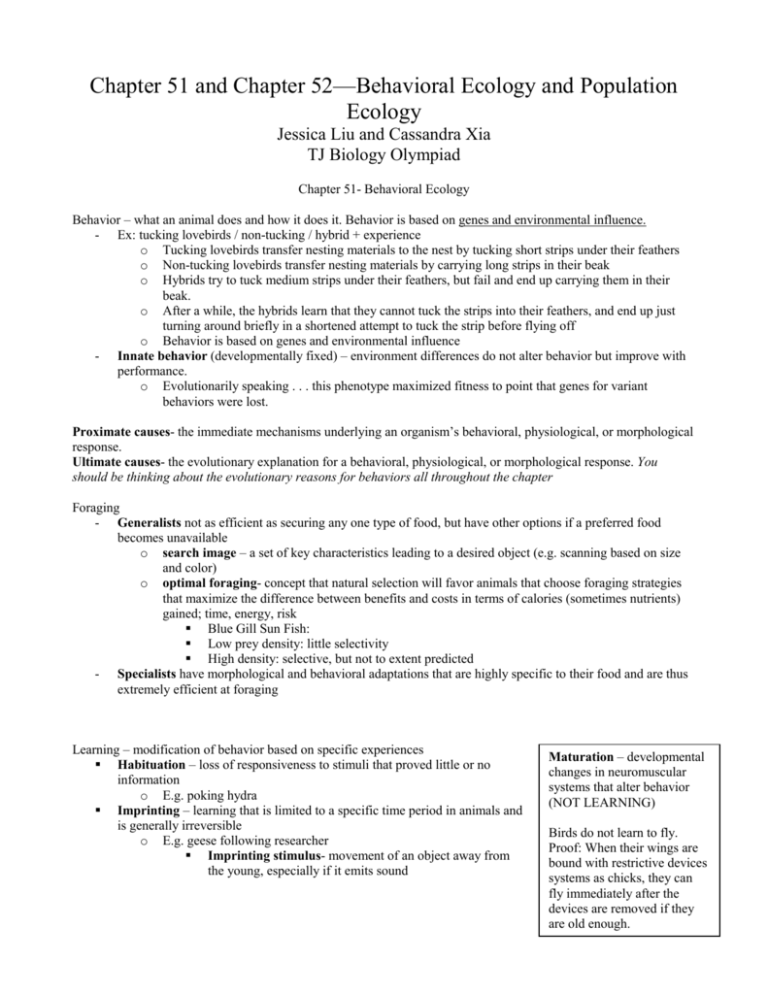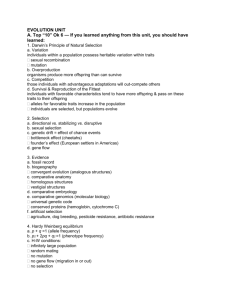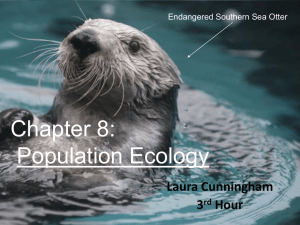Chapter 51 – Behavioral Biology
advertisement

Chapter 51 and Chapter 52—Behavioral Ecology and Population Ecology Jessica Liu and Cassandra Xia TJ Biology Olympiad Chapter 51- Behavioral Ecology Behavior – what an animal does and how it does it. Behavior is based on genes and environmental influence. - Ex: tucking lovebirds / non-tucking / hybrid + experience o Tucking lovebirds transfer nesting materials to the nest by tucking short strips under their feathers o Non-tucking lovebirds transfer nesting materials by carrying long strips in their beak o Hybrids try to tuck medium strips under their feathers, but fail and end up carrying them in their beak. o After a while, the hybrids learn that they cannot tuck the strips into their feathers, and end up just turning around briefly in a shortened attempt to tuck the strip before flying off o Behavior is based on genes and environmental influence - Innate behavior (developmentally fixed) – environment differences do not alter behavior but improve with performance. o Evolutionarily speaking . . . this phenotype maximized fitness to point that genes for variant behaviors were lost. Proximate causes- the immediate mechanisms underlying an organism’s behavioral, physiological, or morphological response. Ultimate causes- the evolutionary explanation for a behavioral, physiological, or morphological response. You should be thinking about the evolutionary reasons for behaviors all throughout the chapter Foraging - Generalists not as efficient as securing any one type of food, but have other options if a preferred food becomes unavailable o search image – a set of key characteristics leading to a desired object (e.g. scanning based on size and color) o optimal foraging- concept that natural selection will favor animals that choose foraging strategies that maximize the difference between benefits and costs in terms of calories (sometimes nutrients) gained; time, energy, risk Blue Gill Sun Fish: Low prey density: little selectivity High density: selective, but not to extent predicted - Specialists have morphological and behavioral adaptations that are highly specific to their food and are thus extremely efficient at foraging Learning – modification of behavior based on specific experiences Habituation – loss of responsiveness to stimuli that proved little or no information o E.g. poking hydra Imprinting – learning that is limited to a specific time period in animals and is generally irreversible o E.g. geese following researcher Imprinting stimulus- movement of an object away from the young, especially if it emits sound Maturation – developmental changes in neuromuscular systems that alter behavior (NOT LEARNING) Birds do not learn to fly. Proof: When their wings are bound with restrictive devices systems as chicks, they can fly immediately after the devices are removed if they are old enough. o o Critical period- limited phase in an individual animal’s development when learning of particular behaviors can take place Chicks also imprint on parents A day or two after their young hatch, adult herring gulls will accept and defend a strange chick introduced into their nesting territory Sexual imprinting- process by which a young animal learns the characteristics of a desirable mate. Male zebra finches appear to prefer mates with the appearance of their mothers Associative learning – the ability to learn to associate one stimulus with another Classical conditioning – learning to associate an arbitrary stimulus with reward or punishment; o e.g. Pavlov’s dog – Ringing a bell when feeding a dog for several weeks causes the dog to salivate upon ringing the bell even when there is no food. Operant conditioning – used by most animal trainers; animal learns to associate one of its own behaviors with reward or punishment…tending to repeat or avoid the behavior. o E.g. animals should not eat porcupines, press the lever and you get food o What tastes good or bad is likely to be affected by natural selection on the basis of that food’s nutritional value. Play – behavior that has no apparent external good but involves movements closely associated with goal - E.g. Bottlenose dolphins in groups of juveniles, playful stalking in cat and dog species - Why has natural selection selected play when it consumes energy and is risky? - The hypothesis that it perfects a useful behavior is probably incorrect because it has been observed the play behavior does not improve with repetition - Most likely, play is useful because of exercise Animal Cognition – the ability of an animal’s nervous system to perceive, store, process, and use information gathered by sensory receptors - Movement is dependent on cognitive maps – internal representatives of the spatial relationships among objects in surroundings o E.g. bees make maps of foraging areas - Two kinds of movement may occur without cognitive maps: 1. kinesis – simple change in activity rate in response to a stimulus E.g. snowbugs and woodlice are less active in humid than dry, causing them to stay there. 2. taxis – automatic movement toward or away from some stimulus. E.g. Housefly larvae move away from light after feeding. Trout always orient upstream. - Migration requires extensive cognitive maps. Animals migrate in one of three ways: 1. piloting- moving from one familiar landmark to another until reaching the destination (used for short distances) 2+3) Use Earth’s 2. orientation- detects compass direction and travels in a straight line magnetic field, the sun, 3. navigation- determines present location and compass direction stars, or an internal clock Social behavior- interaction between two or more animals, usually of the same species Sociobiology = The scientific study that examines evolutionary explanations for social behaviors within species - Even when behavior requires cooperation, each participant acts in a way that will maximize its benefit - Agnostic behavior - contest involving both threatening and submissive behavior in which the victor gains access to a recourse like food or mate (combat + ritual) Ritual - use of symbolic activity so no serious harm is done (depends upon scarcity) Ends quickly Feeding, mating, and rearing young are all defended by agnostic behavior - Dominance hierarchies – “pecking order” Alpha (assured resources), beta, … omega (do not waste energy or risk harm) Wolves: alpha female controls mating. When food is scarce, she allows less to the rest of the pack to allow food for her young - Territoriality - Behavior in which an animal defends a bounded physical space against encroachment by other individuals, usually of its own species. Defense may involve direct aggression or indirect mechanisms such as scent marking, songs, and howling. Helps stabilize population Mating Behavior - Often times animals view any organism of the same species as a threatening competitor to be driven off - Complex courtship interaction - Parental investment – time and energy an individual must expend to produce offspring. Females tend to be more choosy because they have high parental investment Process called “assessment” Based on genetic quality and parental care Males mate with as many as possible Pronounced secondary sex characteristics Sexual selection – (mostly female) selection (of males) based on variation in secondary sex characteristics, leading to the enhancement of sexual dimorphism Lek - (in birds and insects) the males are displayed in a group, while the females visit and choose - Mating systems Promiscuous- type of mating where no strong pair-bonds or lasting relationships occur Monogamous- one male mates with just one female (most birds) Polygamous- one sex mates with several others of the opposite sex Polygyny- one male and many females Polyandry- one female and many males Mating systems depend upon the needs of young and certainty of paternity (internal vs. external fertilization) Communication - Sender produces detectable change in receiver - Evolved because of fitness of sender is increased by the effect the message has on the receiver - Visual, auditory, chemical (olfactory), tactile, electrical - Dependent on lifestyle Most mammals nocturnal --> olfactory and auditory Birds and humans are diurnal --> visual and auditory - Pheromones- chemical signals emitted by animals to communicate by odor Example: the pheromones produced by bee queen and the daughters maintain social order Round vs. waggle dance (bees) Round = nearby food source Waggle = further away food source Altruism- a behavior that reduces the reproductive fitness of one while increasing the fitness of the recipient - Natural selection favors: o Higher reproductive success o Higher genetic representation by offspring or relative - Inclusive fitness- describes the total effect an individual has on proliferating its genes by: o Producing its own offspring o Providing aid that enables other close relatives to increase production of offspring - Reciprocal altruism- no kinship o Only adaptive if favor is returned o Example: baboons help to fight, wolves give food Chapter 52- Population Ecology Population—group of individuals of a single species living in the same general area. They’ll most likely be influenced by similar things and evolve based on their genetic composition Density—the number of individuals per unit area (like trees) or volume (phytoplankton in water) - Dispersion—how individuals are spaced in a population · Clumped—live in groups of animals, like wolves; this is the most common pattern of dispersion · Uniform—spaced…uniformly? Like king penguins. (if you don’t know what uniform means, I can’t really help you with understanding this one, sorry ><); usually results from territoriality—basically, if Penguin A walks in Penguin B’s bubble, they fight. (Some animals have bigger bubbles than others) · Random—random, as in Math.random(). For example, dandelions, whose seeds are dispersed by wind; this pattern is, surprisingly, actually relatively rare - Mark-recapture method—researcher captures some animals, marks them, lets them go, some time passes. The researcher recaptures some number of animals and observes the ratio of marked to unmarked individuals to guesstimate the number of individuals in the population: Immigration means individuals come into population; Emigration means they leave. So, immigration means they’re FOBs, emigration means they’re… I don’t know. Demography—population statistics (not that you really care) - Life tables—show how many people are still alive by some age - Cohort—group of individuals that are of the same age. Life tables are constructed by following a cohort, and seeing how quickly they die. Err… live. (from birth until death) - Survivorship curve—what you get when you graph a life table. Humans are Type I; Squirrels are Type II; Oysters are Type III. (That last sentence was not a joke.) - Reproductive table—follows the reproductive output of a cohort (in average offspring per female) Life history—affected by age at reproductive maturity, frequency of reproduction, number of offspring per reproduction Figure 1. Survivorship curve: I guess trees work for Type III too, but - Semelparity (big-bang reproduction)— personally I like the oyster example better (it’s a little more intuitive). organism produces lots of offspring in one opportunity and dies - Iteroparity (repeated reproduction)—organism produces a few offspring multiple times in its life - Iteroparity is favored in areas where offspring usually survive - An organism can’t mix semelparity and iteroparity, producing lots of offspring lots of times, because time, energy, and nutrients are limited—some studies found that reproduction decreases the chances of survival Biomath! (modeling populations with exponential growth and stuff like that) - Per capita birth rate (b) is how many offspring are produced per time by an average member of the population; per capita death rate (m) is how many individuals of the population are expected to die per time - Per capita rate of increase (r) is how fast the population is changing: r = b – m. if r > 0, the population is growing, if r < 0, the population is decreasing - Zero population growth (ZPG) occurs when the population doesn’t change, or b = m - Exponential population growth = rmzxN; rmax is intrinsic rate of increase—how fast the population can theoretically get bigger; N is population size - Logistic population growth is more realistic, because populations have a carrying capacity—the maximum realistically possible size for the population, because of diseases and resources and stuff - - K-Selection—looks like a logistic curve; exhibited by populations at or near carrying capacity (K) - r-Selection—looks like exponential growth; exhibited by populations way below carrying capacity or competition is unlikely Population Regulation. - Density independent—birth/death rate doesn’t change with population density - Density dependent—birth rate falls, death rate rises with increasing population density · Competition for scarce resources causes some organisms to die · Territoriality limits available space, so some organisms become homeless · Higher population density means diseases spread faster · Predators can capture more prey as population Figure 2. The curve labeled a is typical of rselection; the curve labeled b is typical of K-selection density rises, and the predator may end up feeding preferentially on the species · Toxic waste accumulate and poison organisms · Increase in population density causes more aggression between members of the same population Population dynamics—interactions between factors in environment that affect population size - Populations of large mammals are not necessarily stable over time!!! - Metapopulation—group of linked populations; allows immigration/emigration to affect population size Population cycles—more predator means less prey, until the prey die and the predator starves. Then, the predator dies too, and the prey population increases again… like hares and lynxes. Human populations - Demographic transition—transition from ZPG due to high birth rate – high death rate to ZPG due to low birth rate – low death rate - Age structure—relative number of individuals of each age in a country; this can be shown in “pyramids”—large base means rapid population growth, almost even base means slow population growth, small base means population decrease - Infant mortality—number of infant deaths per 1000 live births - Life expectancy at birth—predicted age individual will live to at the time of birth; reflects quality of life they will probably face - Estimates of the carrying capacity of the Earth for humans vary from < 1 billion to > 1trillion Figure 3. Hare/lynx population cycle. (Run, bunny, run!) Ecological footprint—how much land and water area each nation needs to produce the resources it needs and consume the wastes it produces; “ecologically productive areas” considered in this model: arable land, pasture, forest, ocean, built-up land, fossil energy land - Ecological capacity—how much area is actually available to each country - If ecological footprint > ecological capacity, the country is above carrying capacity









